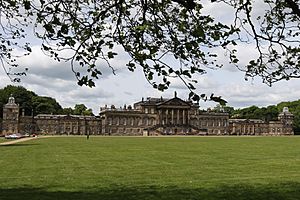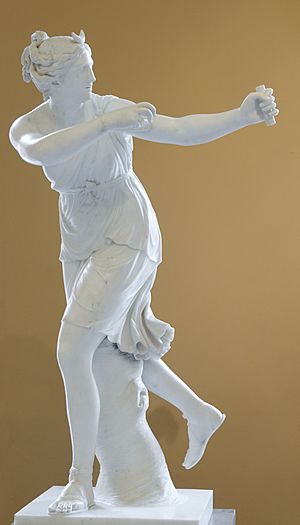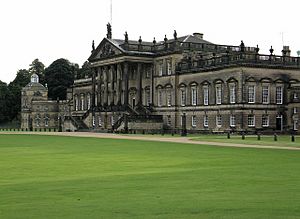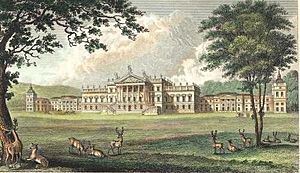Wentworth Woodhouse facts for kids
Quick facts for kids Wentworth Woodhouse |
|
|---|---|

East front of Wentworth Woodhouse
|
|
| General information | |
| Status | Under restoration |
| Type | Stately home |
| Architectural style |
|
| Location | Wentworth, South Yorkshire |
| Country | England |
| Coordinates | 53°28′27″N 1°24′17″W / 53.47417°N 1.40472°W |
| Owner | Wentworth Woodhouse Preservation Trust |
| Design and construction | |
| Architect |
|
| Other information | |
| Parking | Yes |
|
Listed Building – Grade I
|
|
| Designated | 29 April 1952 |
| Reference no. | 1132769 |
| Designated | 1 June 1984 |
| Reference no. | 1001163 |
Wentworth Woodhouse is a huge country house located in the village of Wentworth, in South Yorkshire, England. It's so big it has over 300 rooms and covers more than 2.5 acres! The house is surrounded by a large 180-acre park and a 15,000-acre estate. Today, it is owned by the Wentworth Woodhouse Preservation Trust, which is working to restore it.
The original house was built in the Jacobean style. It was later rebuilt and greatly expanded by Thomas Watson-Wentworth, 1st Marquess of Rockingham. His son, Charles Watson-Wentworth, 2nd Marquess of Rockingham, who was Prime Minister twice, made it a very important place for political discussions. The house stayed in the Fitzwilliam family until 1979. They became very wealthy because of the large amounts of coal found on the estate.
Contents
Exploring Wentworth Woodhouse
Wentworth Woodhouse is actually two houses joined together. They form a west front and an east front. The older part, the west front, was made of brick with stone details. It faced the village.
The east front is incredibly long. People say it was built because of a rivalry with another branch of the Wentworth family. This other family lived at nearby Wentworth Castle. They had rebuilt their home in a grand way, so the owners of Wentworth Woodhouse wanted to make their house even more impressive!
A Look Back at History
The building of the brick-built western part of Wentworth Woodhouse started in 1725. This was after Thomas Watson-Wentworth, 1st Marquess of Rockingham inherited the property in 1723. It replaced an older Jacobean house.
Later, around 1734, the Earl of Malton (who was Thomas Watson-Wentworth) decided to build an even bigger house. This new part, the east front, faced the other way. It was inspired by a famous house called Wanstead House. Many important architects worked on the house over the years. They added new parts and made sure it looked magnificent.
The grand east front is the one most often shown in pictures. The west front, which was the private side, looked out onto a special garden. This garden was meant for the family to enjoy.


Wentworth Woodhouse was later inherited by Charles Watson-Wentworth, 2nd Marquess of Rockingham. He was Prime Minister of the United Kingdom for a short time. Famous people, like Benjamin Franklin, visited him there. An architect named John Carr added more to the east front. He also added grand entrances to the wings of the house.
One room was even named the Whistlejacket Room. It held a famous painting of a racehorse called Whistlejacket by George Stubbs. The Marquess also wanted a sculpture gallery, and some beautiful marble statues were made for it. These statues are now in museums around the world.
After the Marquess, the house and everything in it went to the family of his sister, the Earls Fitzwilliam.
The Amazing Park
In 1790, the owner, Lord Fitzwilliam, hired a famous landscape gardener named Humphry Repton. Repton worked to transform the park around the house. He created a beautiful transition from the house to the rolling fields.
He moved some tall stone pillars that looked too small next to the huge house. Even though the park had many interesting features already, Repton found there weren't many trees. He removed rough ground and used men with shovels and donkey-carts to reshape the land. Two large, winding pools were dug, which could be seen from the house. Many new trees were planted to make the park even more beautiful.
Fun Follies in the Park
The grounds of Wentworth Woodhouse have many interesting buildings called "follies." These are structures built for decoration or to make a point, rather than for practical use. Many of them have stories connected to the politics of the 1700s.
Hoober Stand
This is a tall, pyramid-shaped tower with a hexagonal top. It's about 30 meters (98 feet) high. It was built in 1747–48 to celebrate the defeat of a rebellion in 1745. The owner, Lord Malton, helped fight in this rebellion. So, the monument also shows the family's importance. You can visit this tower on some Sunday afternoons in the summer.
Keppel's Column
This is a 35-meter (115-foot) tall column. It was built to remember Admiral Keppel, a friend of the Marquess of Rockingham. Admiral Keppel had been cleared of charges in a court-martial. The column looks a bit bulging because its height was changed during building due to money issues.
The Rockingham Mausoleum
This is a three-story building, 27 meters (90 feet) high, hidden in the woods. It was built in 1783 as a memorial to the first Marquess of Rockingham. The ground floor has a statue of the Marquess and busts of his friends. The middle floor has an open area with columns. The top floor is a Roman-style dome. Like Hoober Stand, you can visit the Mausoleum on summer Sunday afternoons.
Needle's Eye
This is a 14-meter (46-foot) tall sandstone pyramid with an arch through the middle. It's said to have been built after the second Marquess bet he could drive a coach and horses through the eye of a needle.
Bear Pit
This structure has two levels with a spiral staircase. The outer doorway is very old, from around 1630. At the end of the garden, there's a grotto with two life-sized statues of Roman soldiers guarding it.
A Royal Visit in 1912
King George V and Queen Mary visited Wentworth Woodhouse in July 1912. They stayed for four days. Many important guests joined them at the house.
The visit ended with a special torchlight show by miners. There was also music from local choirs. A huge crowd of 25,000 people gathered on the lawn. The King and Queen appeared on the balcony, and the King gave a speech.
Secret Work During World War II
During the Second World War, Wentworth Woodhouse was used as a training center for the Intelligence Corps. This was a special group that gathered information. Soldiers learned skills like riding motorcycles, which they often used for their work. The grounds and roads around the house were used for motorcycle training.
Coal Mining Near the House
In 1946, a lot of heavy machinery arrived at Wentworth Woodhouse. The government ordered coal to be mined from the estate, very close to the house. This area had a lot of coal near the surface. The land in front of the house became the biggest open-cast mining site in Britain at the time. Over 132,000 tons of coal were dug up just from the gardens.
The government said the coal was needed after the war. However, many people thought it was also a way to show power over the wealthy landowners. A study found the coal was "very poor stuff" and "not worth the getting." But the mining continued, destroying 99 acres of lawns, woods, and gardens. Old trees were pulled up, and huge piles of dirt were left in front of the house.
Local people, including miners, supported the Earl. They did not want Wentworth Woodhouse to be destroyed. The Fitzwilliam family was known for treating their workers well. The local miners even threatened to strike to stop the mining. But the mining continued into the 1950s. The mined areas took many years to recover, and many of the formal gardens were never replaced.
New Chapters for the House
After the war, the Fitzwilliam family's wealth decreased. Many of the house's valuable contents were sold at auctions.
Lady Mabel College
The government wanted to use the house for homeless families. To prevent this, the Earl tried to give the house to the National Trust, but they didn't take it. Finally, Lady Mabel Fitzwilliam, the Earl's sister, made a deal. Most of the house was leased to an educational college. From 1949 to 1979, it was home to the Lady Mabel College of Physical Education. This college trained female physical education teachers.
Sheffield City Polytechnic
From 1979 to 1988, students from Sheffield City Polytechnic (now Sheffield Hallam University) used Wentworth Woodhouse. Some departments were based there. The main house had student accommodation, a dining room, and kitchens. New student housing was built in the deer park. The Stable Block became a busy center with offices, classrooms, and a swimming pool.
New Owners and Restoration
By 1989, Wentworth Woodhouse needed a lot of repairs. The family decided to sell the house and 70 acres around it. A local businessman bought it and started restoration work. But due to business problems, it was sold again in 1998 to Clifford Newbold. He continued the renovation work.
In 2016, the Wentworth Woodhouse Preservation Trust bought the house for £7 million. Later that year, the UK government announced a grant of £7.6 million for restoration work. Some people thought the house might have inspired "Pemberley" in Jane Austen's novel Pride and Prejudice. However, the Jane Austen Society said there was no evidence she had visited the estate.
Wentworth Woodhouse has been featured in a BBC series called The Country House Revealed.
Filming Location
The house and its grounds have been used as a setting for many films and TV shows, including:
- Wives and Daughters (1999)
- Pride and Prejudice (2005)
- Mr. Turner (2014)
- Jonathan Strange & Mr Norrell (2015)
- Victoria (2016)
- Darkest Hour (2018)
- Downton Abbey (2019)










